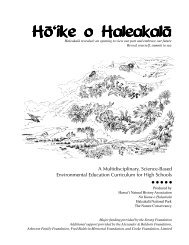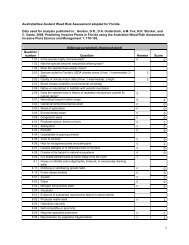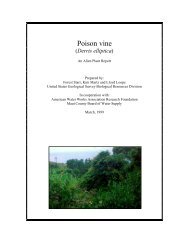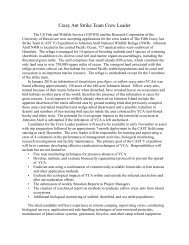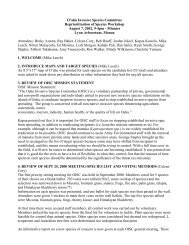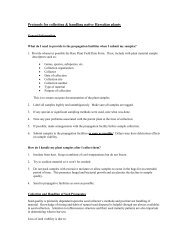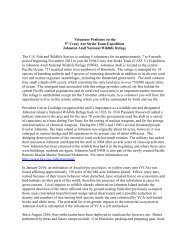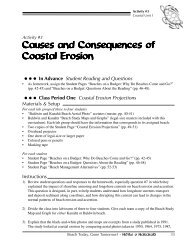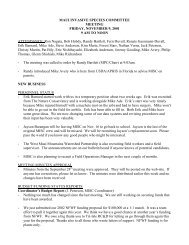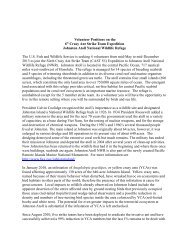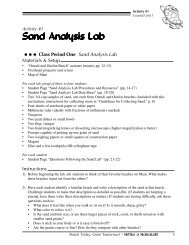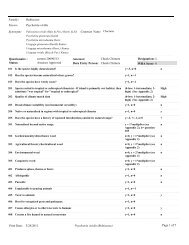Report to the Republic of Palau: 2008 update on Invasive Plant ...
Report to the Republic of Palau: 2008 update on Invasive Plant ...
Report to the Republic of Palau: 2008 update on Invasive Plant ...
You also want an ePaper? Increase the reach of your titles
YUMPU automatically turns print PDFs into web optimized ePapers that Google loves.
een planted <strong>on</strong> Babeldaob and is reproducing. Much more prolific reproducti<strong>on</strong> can be<br />
expected if a fire occurs. It has a weed risk assessment <str<strong>on</strong>g>of</str<strong>on</strong>g> 15, “high risk”.<br />
Melia azedarach (Chinaberry, pride-<str<strong>on</strong>g>of</str<strong>on</strong>g>-India, Indian lilac) seedlings were seen beneath and<br />
around cultivated plants at a residence and a business in Airai in <str<strong>on</strong>g>the</str<strong>on</strong>g> 2002 survey. It was also<br />
seen in cultivati<strong>on</strong> <strong>on</strong> Koror. Several seedlings were also noted in Koror that appeared <str<strong>on</strong>g>to</str<strong>on</strong>g> be selfsown,<br />
but <str<strong>on</strong>g>the</str<strong>on</strong>g> source was not immediately apparent. In this survey, <str<strong>on</strong>g>the</str<strong>on</strong>g> species was noted in<br />
cultivati<strong>on</strong> <strong>on</strong> Malakal (in <str<strong>on</strong>g>the</str<strong>on</strong>g> gardens near <str<strong>on</strong>g>the</str<strong>on</strong>g> radio <str<strong>on</strong>g>to</str<strong>on</strong>g>wer), at several additi<strong>on</strong>al residences in<br />
Airai and <strong>on</strong> Ngercheu Island (Carp Resort). This species is a prolific producer <str<strong>on</strong>g>of</str<strong>on</strong>g> seed, which is<br />
spread by birds. In <str<strong>on</strong>g>Palau</str<strong>on</strong>g>, it apparently begins <str<strong>on</strong>g>to</str<strong>on</strong>g> flower at a very young age. It is invasive in a<br />
number <str<strong>on</strong>g>of</str<strong>on</strong>g> Pacific locati<strong>on</strong>s, including <str<strong>on</strong>g>the</str<strong>on</strong>g> Cook Islands, French Polynesia and Hawai‘i as well as<br />
in South Africa. It is a “high risk” species with a weed risk assessment score <str<strong>on</strong>g>of</str<strong>on</strong>g> 14.<br />
Melinis minutiflora (molasses grass) is a species that is particularly dangerous in that it is both<br />
invasive and can cause a serious fire hazard. It has modified fire regimes <strong>on</strong> many islands where<br />
it has been introduced (D’An<str<strong>on</strong>g>to</str<strong>on</strong>g>nio and Vi<str<strong>on</strong>g>to</str<strong>on</strong>g>usek, 1992) and it is reported as a serious threat <str<strong>on</strong>g>to</str<strong>on</strong>g><br />
forests in Brazil (C. Martins, pers. comm.). It was reported present by Fosberg et al. (1979).<br />
Raulers<strong>on</strong> et al. (1996) reported it present <strong>on</strong> Babeldaob but rare. We found it <strong>on</strong> <str<strong>on</strong>g>the</str<strong>on</strong>g> north<br />
extensi<strong>on</strong> <str<strong>on</strong>g>of</str<strong>on</strong>g> <str<strong>on</strong>g>the</str<strong>on</strong>g> Compact Road in Ngaraard State. An Australian weed risk assessment gives<br />
this species a score <str<strong>on</strong>g>of</str<strong>on</strong>g> 7, indicating it is <str<strong>on</strong>g>of</str<strong>on</strong>g> high risk.<br />
Panicum maximum [=Megathyrsus maximus, Urochloa maxima] (Guinea grass), while not yet<br />
widespread in <str<strong>on</strong>g>Palau</str<strong>on</strong>g> (it is present <strong>on</strong> Koror and Babeldaob), is ano<str<strong>on</strong>g>the</str<strong>on</strong>g>r grass that can help<br />
perpetuate a fire cycle. It seeds pr<str<strong>on</strong>g>of</str<strong>on</strong>g>usely and <str<strong>on</strong>g>the</str<strong>on</strong>g> seeds are dispersed by wind, birds (e.g.<br />
chestnut mannikins) and flowing water or as a c<strong>on</strong>taminant. It can survive l<strong>on</strong>g periods <str<strong>on</strong>g>of</str<strong>on</strong>g><br />
drought. Fire will sweep through stands <str<strong>on</strong>g>of</str<strong>on</strong>g> this grass but it regenerates rapidly from underground<br />
rhizomes. It is a problem species in Guam and Hawai‘i and is very prevalent in Samoa and<br />
T<strong>on</strong>ga, forming dense stands in open and disturbed areas. Its weed risk assessment score is 17,<br />
“high risk”.<br />
Pennisetum setaceum (fountain grass) was found in cultivati<strong>on</strong> at two residences in Airai and a<br />
resort in Ngerkebesang in 2002 but was not seen in <str<strong>on</strong>g>2008</str<strong>on</strong>g>. It is an attractive ornamental but it can<br />
produce large amounts <str<strong>on</strong>g>of</str<strong>on</strong>g> wind-dispersed seed. While it is most likely <str<strong>on</strong>g>to</str<strong>on</strong>g> be invasive in dry<br />
areas, it could possibly spread in <str<strong>on</strong>g>Palau</str<strong>on</strong>g>. It is a serious problem species <strong>on</strong> dryer sites in Hawai‘i.<br />
It has a weed risk assessment score <str<strong>on</strong>g>of</str<strong>on</strong>g> 26, “high risk”.<br />
Pereskia aculeata (Barbados gooseberry, leafy cactus) was found <strong>on</strong> Ngercheu Island (Carp<br />
Resort). It is invasive in Queensland, Australia, particularly in riparian areas, forming large,<br />
impenetrable clumps. It is a declared noxious weed in South Africa, where it has become a<br />
problem in forestry and c<strong>on</strong>servati<strong>on</strong> areas. Seed is bird-dispersed and it can also spread from<br />
stem fragments. Its weed risk assessment indicates that it is <str<strong>on</strong>g>of</str<strong>on</strong>g> high risk, with a score <str<strong>on</strong>g>of</str<strong>on</strong>g> 13.<br />
Pluchea carolinensis (sour bush) and P. indica (Indian fleabane, Indian pluchea, Indian<br />
camphorweed) are present <strong>on</strong> Peleliu and P. indica is present <strong>on</strong> Angaur. They are shrubby<br />
species with wind-dispersed seed. Pluchea carolinensis is naturalizing extensively <strong>on</strong><br />
T<strong>on</strong>gatapu, T<strong>on</strong>ga, and is reported <str<strong>on</strong>g>to</str<strong>on</strong>g> be widespread but not presently abundant <strong>on</strong> Guam. These<br />
species may have been accidentally introduced as a result <str<strong>on</strong>g>of</str<strong>on</strong>g> military activity as both were also<br />
16



